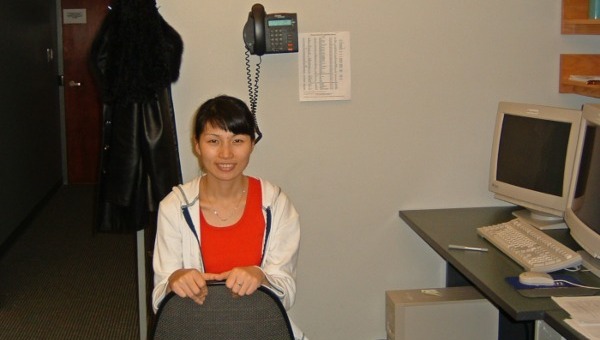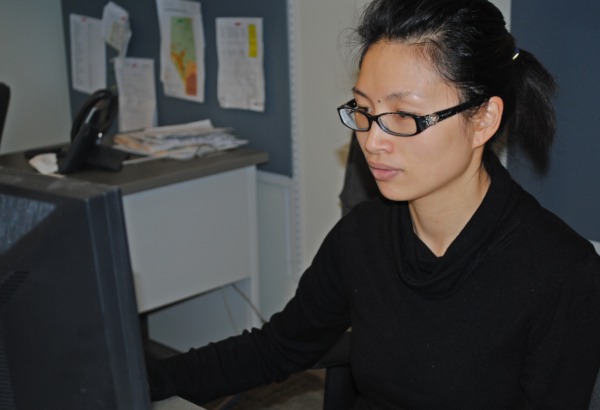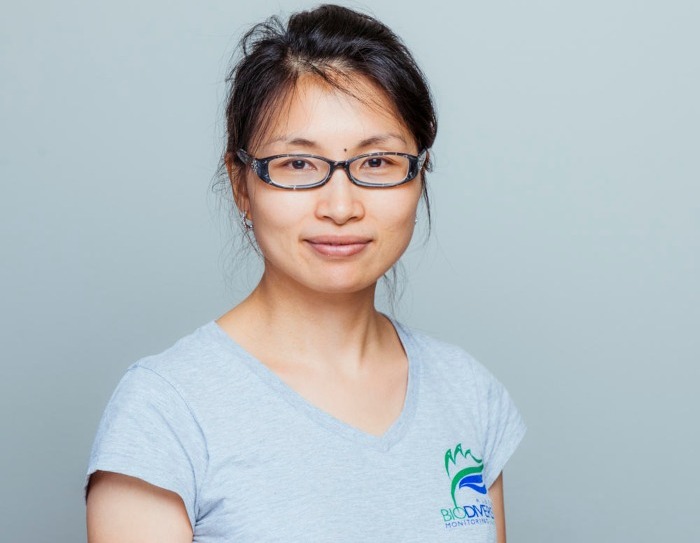February 11 is the International Day of Women and Girls in Science. To celebrate, all February, we’ll be sharing the stories of some of the many women+ at the ABMI who have shaped our organization with their experience, expertise, and dedication. We are inspired by their hard work and the legacy that they are leaving for future scientists. Previous profiles: Fiona Gregory, Cheryl Tebby
Joan Fang, Senior Systems Analyst
Joan Fang is one prolific and dedicated systems analyst. For almost 20 years (even before the ABMI was called the ABMI), Joan has been a mastermind, architect, experimenter, and developer behind numerous computer applications at the ABMI. She is, without exaggeration, the backbone of many of the ABMI’s digital products that allow us to document and share biodiversity data.
Her work as a systems analyst means she has had her hand in many technical projects at the ABMI. Beginning with field work tools (such as programming the digital tablets that our field crews use to document sightings), Joan has worked on various online applications such as the Biodiversity Browser, Wildtrax, the mapping portal, and custom online reports along with quality assurance/control and loading of data onto the ABMI website. A mother of two, Joan makes the tricky balancing act of developing and maintaining cutting-edge digital tools look easy (it’s not, even though she says it is.)
Joan’s Journey
Joan was first exposed to computers at her high school in Longyou County, Zhejiang Province, China. Students there had to put on slippers and lab coats to even enter the computer lab, and projects often involved three people to a computer. At that time, Joan’s teachers encouraged her to enter a computer-programming competition because she was one of the best at math at her school and she happened to be a girl, which the teachers needed for the team. They gave her a book on computer programming to study, and even though this was all relatively new to her, she thought it was “pretty cool.”
Joan went on to receive a Bachelor’s degree in computer science and software at Nankai University in Tianjin City, China, where she earned high marks and was one of only nine female students out of a group of 40. She notes that these women ended up having a huge influence on her as they were at the top of the class and very successful in their careers.

Joan in her lab at graduate school.
After a few years of working as a software engineer at a company in China, she pursued graduate studies in computer graphics at the University of Alberta and she became the first person in her family to graduate with a Masters degree. Joan realized that she preferred engineering and programming application-based projects over research-based work. It was through Joan’s graduate supervisor, who was an ABMI collaborator, that she was introduced to the ABMI. Since then, Joan has been a part of the ABMI’s growth, fabric and family.
Almost 20 Years of Building Applications
When Joan began at the ABMI, she was the one and only IT staff member, and this meant long hours of programming alone. Fast forward about 20 years and Joan is now senior systems analyst and works with a team of five programmers. This offers both rewards and a new set of challenges for Joan since she needs to communicate her own way of doing things, which she admits is “hard and a learning thing.”
Over the years, projects and programs at the ABMI have evolved greatly in both breadth and complexity, and so have the tools she uses to tackle them. Rather than it being a burden, Joan enjoys keeping up with the latest technology, because “the tools keep evolving and I just keep learning. I like building new tools that can make our lives easier.”

Joan at work at her office at the ABMI.
Joan points out that she enjoys the flexibility that she has at the ABMI. “They give me a free and supportive environment, of course with deadlines, but they allow me to make decisions such as choosing the platforms or the technology I use.” On a typical day, Joan usually meets with her team to discuss and plan multiple projects. She then spends a great deal of time in meetings, guiding her team, planning, programming and debugging.
On the challenging side, designs and tools naturally need regular upgrades and maintenance and may become obsolete within the span of a few years. Joan takes it all in stride: “You build a tool, people like it, in a few years people will demand it to be upgraded…the snowball keeps rolling and rolling.”
Joan is proudest of her contributions to online reports and application projects, as well as Wildtrax and the Biodiversity Browser because they combine beautiful designs with backend architecture and programming. “I enjoy building these applications even though they are time consuming, ” she continues, “there are lots of programmers who don’t have their hair anymore, I have all of my hair.”
Joan’s (Not-so) Secret Mad Skillz
One of Joan’s (not-so) secret skills is troubleshooting. Joan admits that she is well-known for finding solutions to the ever-evolving technical issues in programming. Thanks to curiosity, tenacity, and a willingness to experiment, Joan is often able to find creative solutions – something that has not gone unnoticed by former classmates and coworkers alike, and this, she says, has helped her confidence.
Becoming a Software Engineer
Joan encourages girls, women (or anyone) to become software engineers or developers; to do so, she says it’s important to focus on being open-minded and logical, and understand that projects evolve. She says that “you have to keep learning, reading new things, there’s always something new.” Another key aspect to developing digital applications is the user experience, “you have to consider things from the human side, how people interact and the best way to present it,” she says, “you need a vision, because you build it for others.”
Although the ICT sector is still predominantly male in Canada (women in ICT make up about 31% of the workforce), Joan has not felt a sense of inequality in her own work at the ABMI.
Just Give Me the Source Code
In the future, Joan hopes to be more of an architect and developer of new projects rather than doing detailed coding. She plans on expanding her IT team and tackling more ambitious projects. For now, Joan is happiest digging into code, teaching herself and learning from others. “Just give me the source code and I can learn what I need to know…you cannot invent things on your own, so, I look at the code and learn the new trends and understand how to use it. It can definitely make our lives so much easier.”
Links & Resources

